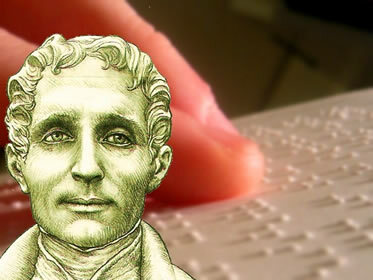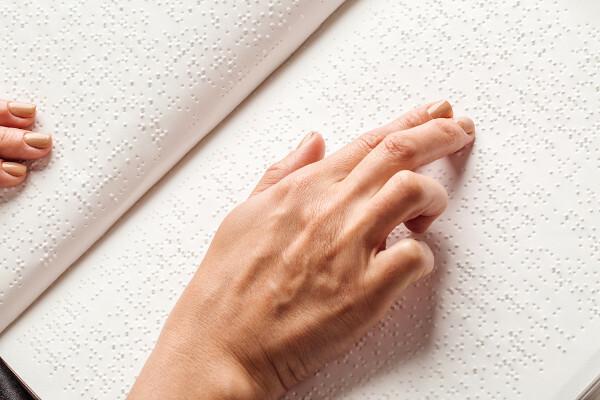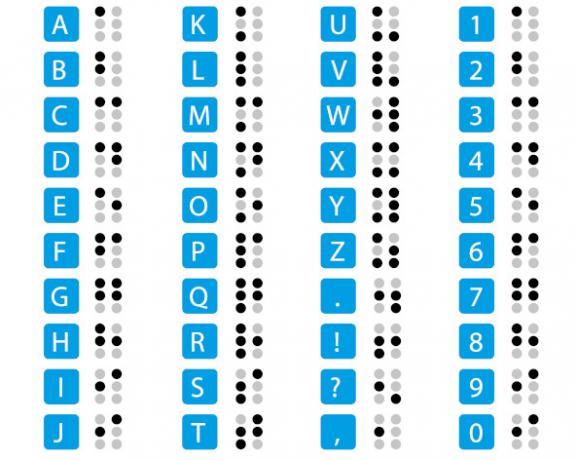O Braille is a system that was made official in 1852 to enable people with partial or total visual impairment to have access to reading. The entire system is formed by embossed characters that allow understanding through the tact.
The system received this nomenclature in tribute to French Louis Braille, responsible for creating this code for the blind. It is used in almost every country in the world, with slight differences from one region to another.
To better understand how the Braille System was created, it is important to first know the story of its founder, Louis Braille.
Read too: Libras - the sign language used in Brazil

Louis Braille Biography
Louis Braille was born in Coupvary, in France, on January 4, 1809. When he was three years old he suffered an eye injury while playing in his father's workshop, piercing the left eye with a sharp object. He suffered a severe hemorrhage that led to an infection. During treatment, the infection ended up reaching the other eye of the boy who,
at the age of five, he went completely blind.Despite the limitation to see, Braille excelled in other skills and found it very easy to memorize the contents given by his teachers. His intelligence left everyone admired and, at age 10, got a scholarship at the world's first school for the blind: the Royal Institute of the Blind in Paris.

At that time, the system used for reading the blind was the Valentin Haüy, which consisted of books printed with large, embossed letters. With this method, it was possible for the blind to perform reading, but it did not allow writing. There were few books in the system, and, along with them, the institution's professors made students repeat the lessons they heard as a form of learning.
Because of this difficulty, Louis decided to further his studies so that there was a better and broader method of studies for blind people. In the midst of this, he also reconciled his routine with music lessons, being a great lover of classical music. He later became a pianist and organist in Notre-Dame des Champs (traditional catholic church in Paris).
Creation of the Braille System
Until reaching the method used today, some formats were tested by Braille, friends, scholars and people who lived with him and who had the same interest in facilitating access to education for blind people.
Louis XIII's army artillery captain, Charles Barbier de la Serre, was one of the people who contributed Louis to the research. Charles had a system of embossed signals to transmit orders to soldiers at night, known as "sonography".
However, even though the signs could be read with your fingertips, they were too complex for memorization and they didn't allow the words to be spelled, because a large number of signs were used to form a single word.

As Braille knew the system and its problems well, he began to look for solutions for the method to be created was more practical and with fewer combinations, allowing to represent the letters, punctuations and numbers. He completed the foundation of its system in 1824, at 15 years of age.
To perfect it, he continued to dedicate himself and published the “Small Synopsis of Arithmetic for Beginners” in 1838, and, in the following year, he published the “New Method for Signal Representation of Letter Shapes, Maps, Geometrical Figures and Musical Symbols for Use of blind”. In the last method published, in 1839, Braille named it "dotted spelling", being accepted by the students and facilitating the Communication.
Although the method has been perfected, and many students have adapted, there was resistance from more conservative teachers, who continued teaching through the Valentin Haüy system.
The Braille system was only officially accepted in1843, when the institute moved its headquarters, and the new director made the method official. With that, the system began to be disseminated by the Europe.
Unfortunately, Braille could not keep up with the success of your system. At 16, he contracted tuberculosis and since then his health has been weakened. In 1852, at the age of 43, his health deteriorated and he died.
Braille in Brazil
At the same time that the Braille system was being adapted at the Royal Institute of the Young Blind in Paris, a young Brazilian was studying at the site: José Álvares de Azevedo. The young man from a wealthy family, son of the writer Álvares de Azevedo, was born blind. Between 10 and 16 years old, he was sent to the institute to study.
There, he learned well the entire method used in Braille and returned to Brazil with a strong desire to expand knowledge for other visually impaired people. He began to give classes, lectures and teach the population how Braille worked.
As a teacher, he managed to get close to the Emperor D. Pedro II, who, admired by José's work, helped him in foundation of a school for the blind in Brazil. In 1854, the Imperial Institute of the Blind Children was created, which today bears the name of Instituto Benjamin Constant, located in the Urca neighborhood of Rio de Janeiro.
However, the young teacher was unable to witness the realization of this dream. He died at age 20, six months before the opening, also a victim of tuberculosis. José Álvares was born on April 8, 1934, and his birth date, as a way of honoring him, was chosen in Brazil as the National Braille Day.
![Monument in Rio de Janeiro pays homage to Louis Braille. [1]](/f/b15d9cbfdfab672806995ff9947d88e3.jpg)
See more: December 13 - Day of the Blind
Braille system
This system is a embossed code aimed at people with visual impairments. The process is the most adopted in the world and, in addition to letters and numbers, it offers symbols, punctuation and other signs that facilitate the understanding of a message by those who cannot see.
Through the touch of hands, people who have knowledge of Braille characters can read all kinds of information. Braille has an embossed structure, formed by six vertical dots divided into two columns of three dots each. The system allows combinations that form letters, numbers and symbols.
The set allows the formation of 63 symbols, however, the space that is not occupied by the dots is also considered as a sign and, therefore, many experts believe that the Braille system has 64 symbols.
See below the symbols for the alphabet and numbers:

In the case of the Portuguese language, the signs retain their original characteristics, but as there are some vowels with accents and other symbols, in Brazil there are some exclusive signs. Below are some signs used to represent accents:
![Some signs used in Brazilian spelling. [2]](/f/5e6f38c84c4ff18c2e6052b43b190e06.jpg)
In addition, the Braille System has rules that must be followed. There are rules for the use of uppercase and lowercase letters, as well as rules for acronyms, abbreviations, using numbers and letters together, and many others.
To learn about all Braille standards and information in Brazil, access the Braille spelling manual for the Portuguese language released by the Ministry of Education (MEC).
How do you read Braille?
THE reading is tactile, done from left to right and passing letter by letter. Readers can choose to use either one hand or both hands, whichever way suits best.
In the case of two-handed reading, bimanual, each is used to read half a paragraph. When reading with just one hand, one-manual, it goes back to the middle of the paragraph to go down from there to the next line of text.
Although Braille is used by blind people and its reading is considered tactile, it can also be read only by its characters by people who are not visually impaired. This reading is simple, and interested people need only memorize the symbols.
reading vs writing
Even though Braille is a well-known system for reading, it presents a more complicated process in your writing. Almost everyone can read the Braille system, but few can write it.
Braille writing, if done by hand, is more difficult. In order for it to present the relief, it must be made with a burin (steel tool with a cutting tip, used in engraving on metal or wood to open fine lines), in an inverted way. In this case, it is done from right to left, but with the symbols inverted, to allow that, when turning the paper, the reliefs are in the direction in which the reading will be made.
For writings made in machines, the process is more practical. With all the technology of today, the machines have specific keys for creating this content. Just as printing systems already have Braille printers, and screen printing includes drops of substance that generate relief and enable the creation of the material.
Importance of Braille
![Braille helps blind people to live a more accessible and independent life [7]](/f/76c65f4a6caf555c0988ef4894f393da.jpg)
Using the Braille system is a form of social inclusion. With it, it is possible to provide more accessibility to people with visual impairment, also contributing to greater independence of this audience, in addition to access to teaching, learning, the labor market and other activities that are part of the routine of all people.
In addition to educational institutions aimed at serving this audience, it is also important that resources are included in places and even objects that are part of everyone's life.
See more: December 3 – International Day of People with Disabilities
How to learn Braille
Learning Braille may be a necessity for some people or just a curiosity. Despite this, knowing a little about this writing method is very important so that all of us can also contribute to those who need our help at some point in life.
That's why there are several options for those who want to learn a little about the Braille system and, for that, each one must take into account their level of difficulty to learn.
THE Internet it can be a great ally for the study of signs, as a simple search shows all the existing signs, and you can start to memorize them. You can also buy books in braille to get a closer experience of how the system works and, with the help of research, begin to understand this tactile alphabet.
For those who want to further deepen their knowledge of Braille, it is necessary to seek a educational institution or a specialized teacher to teach the content.
Image credits
[1] Aguiarbpc / Shutterstock
[2] Reproduction of the MEC Manual
By Giullya Franco
Journalist
